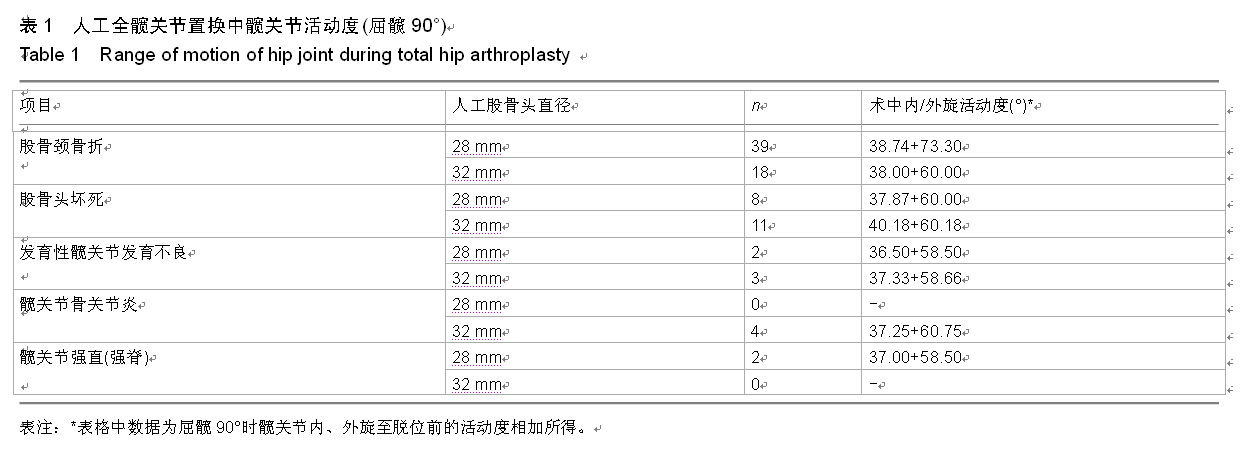| [1] 史占军,李朋,王健.全髋关节置换术后脱位的预防与处理[J]. 中国矫形外科杂志,2008,16(18):1389-1392.
[2] SooHoo NF, Farng E, Lieberman JR, et al. Factors that predict short-term complication rates after total hip arthroplasty. Clin Orthop Relat Res. 2010;468:2363-2371.
[3] Sadr Azodi O, Adami J, Lindstrom D, et al. High body mass index is associated with increased risk of implant dislocation following primary total hip replacement: 2,106 patients followed for up to 8 years. Acta Orthop. 2008;79:141.
[4] Bystrom S, Espehaug B, Furnes O, et al. Femoral head size is a risk factor for total hip luxation: a study of 42,987primary hip arthroplasties from the Norwegian Arthroplasty Register. Acta Orthop Scand. 2003;74:514.
[5] 龙浩,董伟强,白波.人工股骨头置换术后股骨头脱位的原因分析[J].中华关节外科杂志(电子版),2009,3(4):463-467.
[6] Kluess D, Martin H, Mittelmeier W, et al. Influence of femoral head size on impingement, dislocation and stress distribution in total hip replacement. Med Eng Phys. 2007;29:465.
[7] Padgett DE, Lipman J, Robie B, et al. Influence of total hip design on dislocation: a computer model and clinical analysis. Clin Orthop Relat Res. 2006;447:48.
[8] Howie DW, Holubowycz OT, Middleton R. Large Articulation Study Group. Large femoral heads decrease the incidence of dislocation after total hip arthroplasty: a randomized controlled trial. J Bone joint Surg Am.2012:94(12): 1095-1102.
[9] Zagra L, Anasetti F, Bianchi L, et al. No difference in gait recovery after THA with different head diameters: a prospective randomized study. Clin Orthop Relat Res. 2013; 471(12):3830-3837.
[10] 罗志平,戴闽.不同股骨头颈直径比与髋臼角对人工髋关节活动的影响[J].中国矫形外科杂志,2005,13(10):757-760.
[11] Crowninshield RD, Maloney WJ, Wentz DH, et al. Biomechanics of large femoral heads: what they do and don’t do. Clin Orthop Relat Res. 2004;429:102-107.
[12] Burroughs BR, Hallstrom B, Golladay GJ, et al. Range of motion and stability in total hip arthroplasty with 28-, 32-, 38-, and 44-㎜ femoral head sizes: an in vitro study. J Arthroplasty. 2005;20:11-19.
[13] Khan MA, Brakenbury IS, Reynolds SR. Dislocation following total hip replacement. J Bone Joint Surg Br. 1981;63:214-218.
[14] Lachiewicz PF, Soileau ES.Dislocation of primary total hip arthroplasty with 36 and 40-mm femoral heads. Clin Orthop Relat Res. 2006;453:153-155.
[15] Blumenfeld TJ, Bargar WL. Use of larger femoral heads in revision total hip arthroplasty: will this solve dislocation. Orthopedics. 2008;31:995.
[16] Kumar V, Sharma S, James J, et al.Total hip replacement through a posteriorapproach using a 22 ㎜ diameter femoral head: The role of the transverseacetabular ligament and capsular repair in reducing the rate of dislocation. Bone Joint J.2014;96-B:1202-1206.
[17] Nadzadi ME, Pedersen DR, Callaghan JJ, et al. Effects of acetabular component orientation on dislocation propensity for small-head-size total hip arthroplasty. Clin Biomech (Bristol, Avon). 2002;17:32.
中国组织工程研究杂志出版内容重点:人工关节;骨植入物;脊柱;骨折;内固定;数字化骨科;组织工程
|

